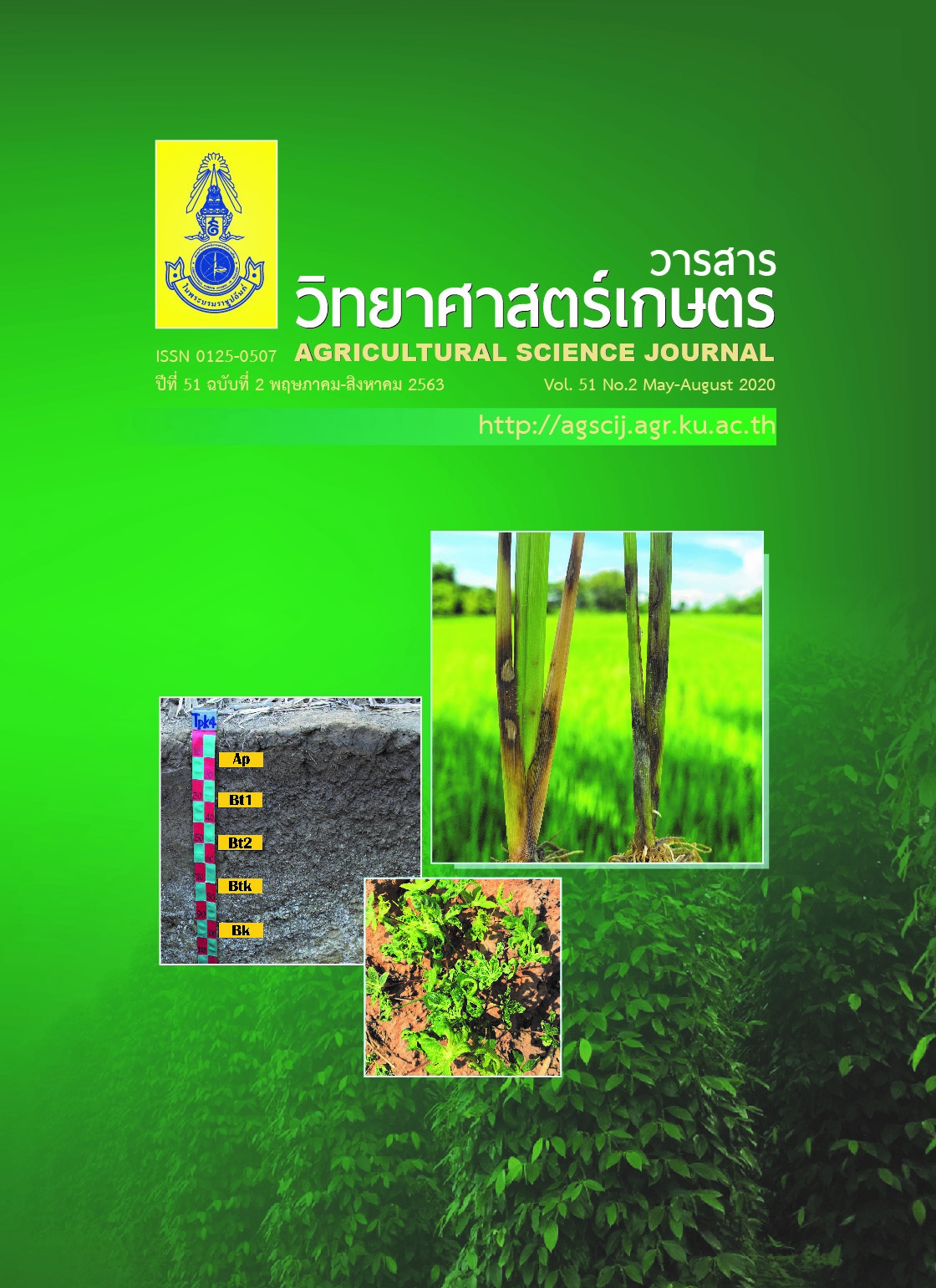ผลของอุณหภูมิต่อคุณภาพและอายุการเก็บรักษาของพริกไทยสด
Main Article Content
บทคัดย่อ
พริกไทย (Piper nigrum L.) เป็นพืชสมุนไพรและเครื่องเทศ ปัญหาสำคัญของพริกไทยสดคือการเกิดสีน้ำตาลของผลซึ่งส่งผลให้มีอายุการวางจำหน่ายสั้น งานวิจัยนี้จึงมีวัตถุประสงค์เพื่อศึกษาหาอุณหภูมิต่ำที่เหมาะสมในการเก็บรักษาและยืดอายุการวางจำหน่ายพริกไทยสด โดยนำพริกไทยสดบรรจุในถาดหุ้มด้วยฟิล์มพลาสติกและนำมาเก็บรักษาที่อุณหภูมิ 5 และ 10 องศาเซลเซียส ความชื้นสัมพัทธ์ 90–95 เปอร์เซ็นต์ ระยะเวลา 18 วัน ประเมินคุณภาพของพริกไทยสดที่เก็บรักษาที่อุณหภูมิต่ำอย่างต่อเนื่องทุก 2 วัน เปรียบเทียบกับพริกไทยสดที่เก็บรักษาที่อุณหภูมิต่ำ และนำมาวางไว้ที่อุณหภูมิ 25 องศาเซลเซียส ความชื้นสัมพัทธ์ 80–85 เปอร์เซ็นต์ เป็นเวลา 2 วัน วางแผนการทดลอง แบบสุ่มสมบูรณ์ กรรมวิธีมี 3 จำนวนซ้ำ จำนวนซ้ำละ 1 ถาด แต่ละถาดมีพริกไทยสด 5 ช่อ จากผลการศึกษา พบว่า พริกไทยสดบรรจุในถาดหุ้มฟิล์มพลาสติก สามารถเก็บรักษาที่อุณหภูมิ 5 และ 10 องศาเซลเซียส ได้นาน 10 วัน โดยเมื่อนำมาวางไว้ที่อุณหภูมิสูงขึ้นมีการเกิดสีน้ำตาลของผล ก้านช่อผล และการเหี่ยวของผลน้อย รวมทั้งยังมีการยอมรับของผู้บริโภคด้านกลิ่น ทั้งนี้ การเก็บรักษาผลพริกไทยสดอย่างต่อเนื่องที่อุณหภูมิ 5 องศาเซลเซียส ส่งผลให้พริกไทยสดมีน้ำหนักสดและการยอมรับของผู้บริโภคด้านกลิ่นมากกว่า รวมทั้ง แสดงอาการสีน้ำตาลของผล ก้านช่อผล การผลิตเอทิลีน และการหายใจน้อยกว่าพริกไทยสดที่เก็บรักษาอย่างต่อเนื่องที่อุณหภูมิ 10 องศาเซลเซียส โดยพริกไทยสดเก็บรักษาอย่างต่อเนื่องที่อุณหภูมิ 5 และ 10 องศาเซลเซียส มีคุณภาพเป็นที่ยอมรับของผู้บริโภค ตลอดระยะเวลาการเก็บรักษา 18 และ 16 วัน ตามลำดับ
Article Details
เอกสารอ้างอิง
Boonyakiat, D. 2013. Postharvest Management of Horticulture. Odean Store Publishing, Bangkok, Thailand. 360 pp. (in Thai)
Brackmann, A., J. Streif and F. Bangerth. 1993. Relationship between a reduced aroma production and lipid metabolism of apples after long-term controlled atmosphere storage. J. Am. Soc. Hortic. Sci. 118: 243–247.
Caleb, O.J., P.V. Mahajan, F.A. Al-Said and U.L. Opara. 2013. Modified atmosphere packaging technology of fresh and fresh-cut produce and the microbial consequences. Food Bioprocess Tech. 6: 303–329.
Couey, H.M. 1982. Chilling injury of crops of tropical and subtropical origin. HortScience. 17: 162–165.
Ketsa, S. 1995. Storage of tropical fruits in Thailand, pp. 75–79. In Proc. the Fruit Production in the Tropics and Subtropics. Japan International Research Center for Agricultural Science (JIRCAS), Ministry of Agriculture, Forestry and Fisheries, Tsukuba Ibaraki, Japan.
Lim, C.S., S.M. Kang, J.L. Cho, K.C. Gross and A.B. Woolf. 2007. Bell pepper (Capsicum annuum L.) fruits are susceptible to chilling injury at the breaker stage of ripeness. HortScience 42: 1659–1664.
Liu, H., W. Jiang, J. Cao and Y. Li. 2019. Effect of chilling temperatures on physiological properties, phenolic metabolism and antioxidant level accompanying pulp browning of peach during cold storage. Sci. Hortri. 255: 175–182.
Lyons, J.M. 1973. Chilling injury in plants. Ann. Rev. Plant Physiol. 24: 445–466.
Moon, K.M., E.B. Kwon, B. Lee and C.Y. Kim. 2020. Recent trends in controlling the enzymatic browning of fruit and vegetable products. Molecules. 25: 2754.
Morris, L.L. 1982. Chilling injury of horticultural: an overview. HortScience. 25: 161–162.
Shi, J., J. Zuo, F. Zhou, L. Gao, Q. Wang and A. Jiang. 2018. Low-temperature conditioning enhances chilling tolerance and reduces damage in cold-stored eggplant (Solanum melongena L.) fruit. Postharvest Biol. Technol. 141: 33–38.
Siripanich, J. 2010. Postharvest Biology and Plant Senescence. 3rd edition. National Agricultural Extension and Training Center, Nakhon Pathom, Thailand. 453 pp.
Sriyong, M., P. Boonyaritthongchai and C. Wongs-Aree. 2010. Quality and oleoresin changes of fresh pepper under various MAPs. Agricultural Sci. J. 41(Suppl.1): 149–152. (in Thai)
Suamsiri, P. 2008. Spice Industry. 3rd edition. Wanida Press, Chiangmai, Thailand. 292 pp.
Wang, C.Y. 1994. Chilling injury of tropical horticultural commodities. HortScience 29: 986–988.
Watkins, C.B., S. Picton and D. Grierson. 1990. Stimulation and inhibition of expression of ripeningrelated mRNAs in tomatoes as influenced by chilling temperatures. J. Plant Physiol. 136: 318–323.
Wills, R.B.H., W.B. McGlasson, D. Graham and D.C. Joyce. 2007. Postharvest: An Introduction to the Physiology and Handling of Fruit, Vegetables and Ornamentals. 5th edition. Oxford University Press, England. 252 pp.
Wongsheree, T., S. Ketsa and W.G. van Doorn. 2009. The relationship between chilling injury and membrane damage in lemon basil (Ocimum × citriodourum) leaves. Postharvest Biol. Technol. 51: 91–96.


